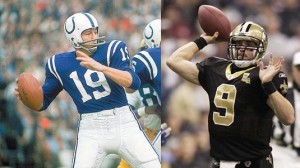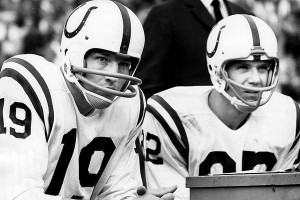Brees Looks To Break The NFL’s “Unbreakable” Record
With a touchdown pass in the New Orleans Saints game against the San Diego Chargers on Sunday, Drew Brees will break the NFL passing record most considered to be unbreakable. Yet while tossing a touchdown pass in his 48th straight game will eliminate Johnny Unitas from the record book, that it took more than 50 years and a complete change in offensive philosophy for the record to be approached makes the Unitas streak seem even more impressive.
When Johnny Unitas started his streak as a rookie for the Baltimore Colts on December 9, 1956, the passing game was used quite differently than it is today. The 1956 Colts ranked sixth in the NFL with 1,921 passing yards on 279 total attempts. By comparison, they were second in the NFL with 2,202 yards rushing on 432 attempts.
In 1956 the Green Bay Packers were the only team in the NFL to throw the ball more than they ran it (353 pass attempts, 337 rushes) and it wasn’t surprising that they finished last in their division with a 4-8 record. Overall in the NFL in 1956 there were 5,453 rushing attempts (37.9 per team per game) compared to 3,282 pass attempts (22.8 per team per game). There were a total of 162 touchdown passes thrown during the season (13.5 per team).
Fast forward to the 2011 season and the change is quite staggering. Drew Brees and the Saints attempted 662 passes in 2011 while running the ball 431 times. Only four teams in the NFL had more rushing attempts than passes. Interestingly enough, of those four teams (Jacksonville, San Francisco, Denver and Houston), three of them made the playoffs. Overall in 2011, there were 17,410 pass attempts in the NFL (34 per team per game) and 13,971 rush attempts (27.3 per team per game). There was a total of 745 touchdown passes thrown (23.3 per team).
Given the improbable ascension to NFL greatness for both players, it seems fitting that it would be Brees who would challenge the record of Unitas.
Neither player entered the NFL with much fanfare or expectations.
After playing collegiately at Louisville, Unitas was drafted in the 9th round of the 1955 NFL Draft by the Pittsburgh Steelers. In a move that epitomizes the futility of the Steelers during that era, the Steelers cut the Pittsburgh area native before the 1955 season.
The next season Unitas joined the Baltimore Colts and, as they say, the rest is history. In just his fifth start, Unitas started his amazing streak by tossing a three-yard touchdown pass to Jim Mutscheller to account for the only Baltimore points in a 31-7 loss to the Rams.
A second round draft pick of the San Diego Chargers in the 2001 draft, Brees had been a solid collegiate player at Purdue, but at only 6-foot tall, many did not think he could be a franchise quarterback in the NFL. Despite four productive seasons as the starting quarterback for the Chargers, Brees was not resigned following the 2005 season in favor of 6-foot-5 inch Phillip Rivers.
Coming off a shoulder injury that many thought would derail his career, Brees joined the Saints in 2006 and in six and a half seasons has become one of the top quarterbacks in the NFL, a Super Bowl Champion and a future Hall of Famer.
When directly comparing the performance of Unitas and Brees during their 47 game streaks, you can really see the differences in eras and offensive philosophy.
During his streak, Unitas connected on 696 of 1,298 passes (53.6%) for 10,645 yards, 102 touchdowns and 61 interceptions with a passer rating of 83.7. In the 47 games, Unitas tossed two or more touchdowns 32 times, including seven games with four. He also threw an interception in 32 games during the streak. Reflecting the continuity of lineups during the era, he tossed touchdowns to only seven receivers with Hall of Famers Raymond Berry (38) and Lenny Moore (27) accounting for the majority.
Perhaps the only stat needed to illustrate just how much more the pass is used today than in the late 1950s is the fact that Brees completed more passes (1,302) during his 47 game streak than Unitas even attempted. Brees connected on 1,302 of 1,891 passes (68.9%) for 14,803 yards, 114 touchdowns and 50 interceptions with a 101.2 passer rating. Brees has 34 multi-touchdown games and thrown an interception in 30 games. A total of 15 different receivers have caught touchdown passes from Brees during the streak with Marques Colston leading the way with 22 and four players catching just one.
Indicative of the difference in the eras and passing philosophies is the huge disparity in yards per completion.
Reflecting the down-the-field style of the era, Unitas averaged 15.3 yards per completion during his streak. In one 1960 game against the Dallas Cowboys, Unitas completed only eight passes, but three of them were touchdown passes of 68, 52 and 70 yards to Berry and another was a 20 yard scoring pass to Moore as he totaled 270 yards (33.75 yards per completion).
Brees has averaged 11.4 yards per completion during the last 47 games. Of his 114 touchdown passes, 24 were for 30 or more yards. That number pales to the 36 touchdowns passes of 30 or more yards (20 of 50 or more yards) tossed by Unitas.
Many experts have called Unitas’ streak the football version of DiMaggio’s 56 game hitting streak. Given the era and that he was able to sustain the level over parts of five seasons, I think it might have been an even more remarkable accomplishment. That it has taken more than 50 years for the streak to be matched in an era when throwing touchdown passes is much more prevalent indicates just how great Unitas was and how impressive his feat.












